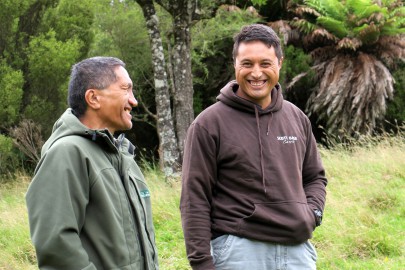
Two generations of Tūhoe, Te Whenua Te Kurapa and Puke Timoti, discuss their impressions of abundance and productivity witnessed in the forests of Te Urewera over their lifetimes.
Ecological indicators based on western science systems are often used in monitoring and reporting to understand environmental change, but the short timeframes in which data are collected can hinder understandings. Increasingly, conservation and restoration organisations are looking to Indigenous peoples to detect and track long-term environmental changes through their direct interactions with natural resources (e.g. customary harvest) or general observations during time on land or sea. However, this type of work often uses language concepts and ordinal scores (e.g. few, some, a lot), so these systems can also be vulnerable to how individuals perceive, experience, and remember past natural resource states.
A recent study by Manaaki Whenua and Tūhoe Tuawhenua Trust set out to determine the relationships between ordinal scores and quantitative estimates (e.g. flock size) used by members of the Tuawhenua community of Ruatāhuna to gauge different forest indicators. The researchers also investigated whether community members of different ages gauged these indicators differently. The researchers showed that while the observed relationships remained consistent across all age classes, there was a significant intergenerational shift in how community members understood the abundance and size of a selected group of species.
The findings suggest the mitigation of shifting ecological baselines will be critical to how kaitiaki perceive change in their environments and determine the scale and level of action and investment required to recover those populations. This will be particularly important for younger kaitiaki who have not witnessed the historical abundance, productivity, and function of past ecosystems. In this regard, kaumātua offer valuable accounts of past and current ecological thresholds.
The protection of customary harvest practices and/or the establishment of community-based environmental monitoring initiatives offer opportunities to maintain contact with species and their environments and track changes.
Iwi- and hapū-led conservation and restoration initiatives stand to benefit from the accounts of kaumātua through strong intergenerational knowledge transfer and community-focused monitoring. It also gives tangata whenua an important stake in future environmental interpretation and decision-making processes, while ensuring a continued interaction with their mātauranga.
Key contact

